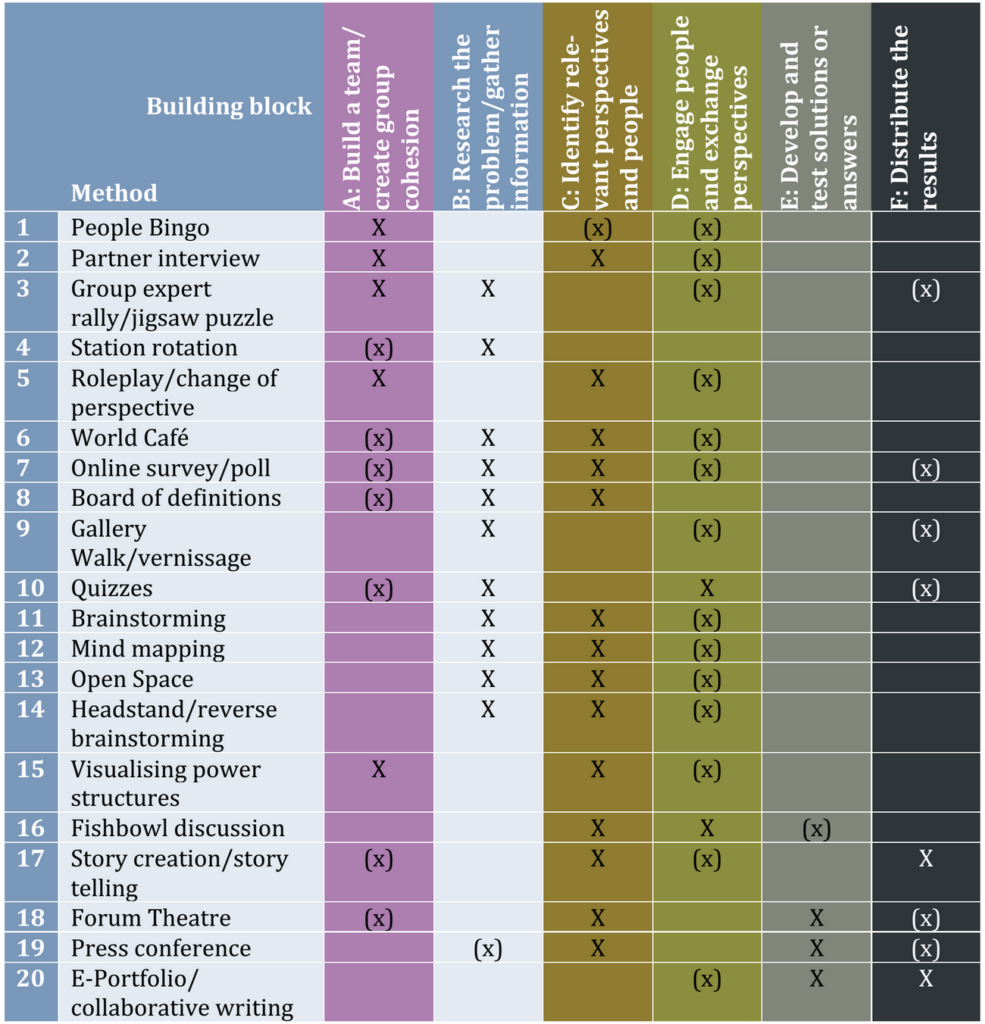Step 7
Choose learning methods and tools: which of them best match the building blocks?
Step 7
Choose learning methods and tools: which of them best match the building blocks?
Step 7
Choose learning methods and tools: which of them best match the building blocks?
The following section presents profiles of 20 teaching methods you can use to design your learning experience while matching them to one or several of the objectives of the archetypal multilogue building blocks. An “X” indicates that a method is clearly suitable for a certain building block; “(x)” means that the method could be employed here but might need some adjustments.
The following section presents profiles of 20 teaching methods you can use to design your learning experience while matching them to one or several of the objectives of the archetypal multilogue building blocks. An “X” indicates that a method is clearly suitable for a certain building block; “(x)” means that the method could be employed here but might need some adjustments.
The following section presents profiles of 20 teaching methods you can use to design your learning experience while matching them to one or several of the objectives of the archetypal multilogue building blocks. An “X” indicates that a method is clearly suitable for a certain building block; “(x)” means that the method could be employed here but might need some adjustments.

By picking and choosing from the methods, you can emphasize different building blocks depending on your learning objectives. If you want to work towards learning objectives such as acquiring foundational knowledge about a certain subject, you would include more methods from the building block “B: Research the problem.” However, if the course is aimed at fostering communication and collaboration skills, you would implement more methods from building block “D: Engage people and exchange perspectives.”
When picking tools for the digital enhancement of the method, make sure the tool complies with the data protection and privacy requirements of your jurisdiction and organization, and that you are comfortable with the competence level required (see step 5). Also, make sure to read up on best-practice examples regarding how to ensure a high level of student engagement and interaction (see the “Further reading” section of this toolkit).

By picking and choosing from the methods, you can emphasize different building blocks depending on your learning objectives. If you want to work towards learning objectives such as acquiring foundational knowledge about a certain subject, you would include more methods from the building block “B: Research the problem.” However, if the course is aimed at fostering communication and collaboration skills, you would implement more methods from building block “D: Engage people and exchange perspectives.”
When picking tools for the digital enhancement of the method, make sure the tool complies with the data protection and privacy requirements of your jurisdiction and organization, and that you are comfortable with the competence level required (see step 5). Also, make sure to read up on best-practice examples regarding how to ensure a high level of student engagement and interaction (see the “Further reading” section of this toolkit).

By picking and choosing from the methods, you can emphasize different building blocks depending on your learning objectives. If you want to work towards learning objectives such as acquiring foundational knowledge about a certain subject, you would include more methods from the building block “B: Research the problem.” However, if the course is aimed at fostering communication and collaboration skills, you would implement more methods from building block “D: Engage people and exchange perspectives.”
When picking tools for the digital enhancement of the method, make sure the tool complies with the data protection and privacy requirements of your jurisdiction and organization, and that you are comfortable with the competence level required (see step 5). Also, make sure to read up on best-practice examples regarding how to ensure a high level of student engagement and interaction (see the “Further reading” section of this toolkit).
